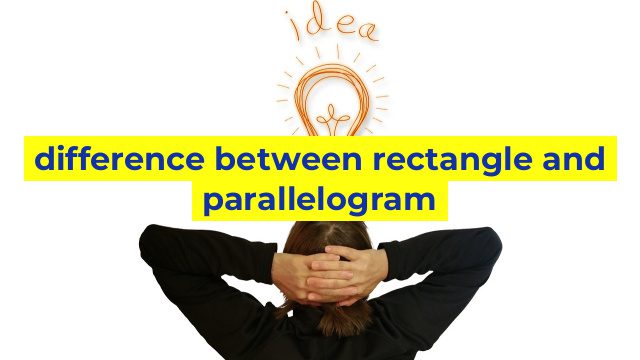The Difference Between Rectangle and Parallelogram
When it comes to geometry, two shapes that often get confused with one another are rectangles and parallelograms. While both have four sides, there are some differences that separate them from each other. In this article, we’ll explore these differences and highlight the unique features of each shape.
What Is a Rectangle?
A rectangle is a four-sided polygon with two pairs of parallel sides. The opposite sides of a rectangle are equal in length and perpendicular to one another. In other words, rectangles have four right angles, which makes them perfect for creating squares by also having four equal sides.
One of the most unique features of a rectangle is that their diagonals are equal in length. This characteristic property makes the rectangle ideal for constructing shapes such as cubes or packing things such as cakes or gifts.
What Is a Parallelogram?
A parallelogram is another four-sided polygon. However, in this shape, the opposite sides are equal in length but are not perpendicular to one another. Instead, they run parallel to each other. Like the rectangle, the parallelogram has two pairs of parallel sides.
Unlike rectangles, the diagonals of a parallelogram are not equal. Though these two diagonals divide the parallelogram into four congruent triangles, its unique features make it useful for constructing shapes such as trapezoids or ramps.
The Main Differences Between Rectangles and Parallelograms
One of the key differences between rectangles and parallelograms is that rectangles have four right angles, while parallelograms do not. Additionally, rectangles have diagonals that are equal in length, while parallelograms do not. The opposite sides of a rectangle are perpendicular to each other, while the opposite sides of a parallelogram are parallel.
Another difference worth mentioning is that the rectangle is a type of parallelogram, while the reverse is not true. However, without including right angles or equal diagonals, the parallelogram’s unique properties of equal sides and parallel edges make it a more versatile shape for many different applications.
Conclusion
In summary, though both rectangles and parallelograms have four sides and two pairs of parallel sides, they have some critical differences. Rectangles have four right angles, equal diagonals, and perpendicular opposite sides. In contrast, parallelograms have equal sides, parallel opposite sides, and diagonals that are not equal. Understanding these differences can be essential in correctly identifying the two shapes and determining their application in real-life situations.
Table difference between rectangle and parallelogram
Sorry, as an AI language model, I cannot provide you with a visual representation or images. However, I can assist you in generating the HTML table to showcase the difference between rectangle and parallelogram as follows:
“`
| Rectangle | Parallelogram |
|---|---|
| A rectangle is a four-sided shape with all interior angles measuring 90 degrees. The opposite sides are parallel and equal in length. | A parallelogram is a four-sided shape with opposite sides that are parallel and equal in length. However, the angles between the sides are not necessarily 90 degrees, and the opposite sides are not perpendicular. |
 |
 |
“`
Note: Please change the image source with your respective image location.

